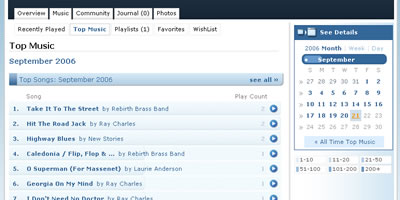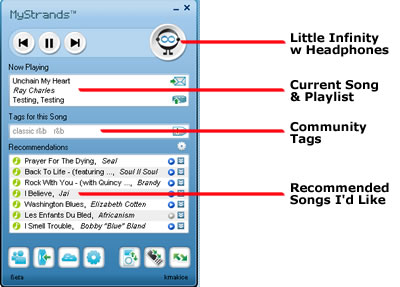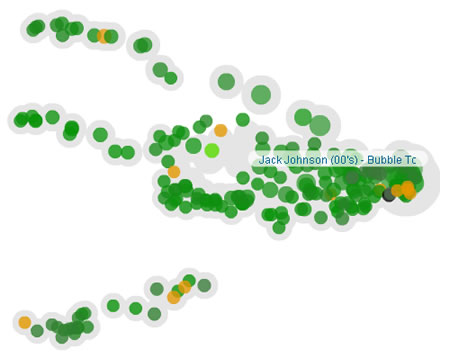So while I’m waiting to get the tech working for a test, Justin went and did his own blog entry on the MyStrands music playlist visualizer. (Some nerve. What, does he think this is his project or something? Sheesh.) Justin gave a presentation on Tuesday to the Networking group at the School of Informatics, fresh off of a trip to Spain for a recommender’s conference. The Lab site at MyStrands already has nice explanation of the tool, too, so I’ll stick to my experience with this information.
Better Recommendations
Justin, an HCI grad who now spends time dabbling in Music Informatics and Complex Systems, got MusicStrands to fund his Ph.D. in exchange for work on improving their recommender system. MyStrands’ mission is to help members of the large community of music lovers discover new tunes through the power of communal knowledge. They attempt to do this with a number of tools, including personal journals, affinity networks, listening history calendars, and soon … Justin’s playlist neighborhoods.
 |
A calendar system keeps track of music listening in the same way a blog keeps an archive of your posts. |
The problem with most recommender systems is that they gravitate toward popularity instead of relevance. They count clicks or votes, which attract more clicks and votes, and the next thing you know everyone is being told to listen to Shakira’s “Hips Don’t Lie” (or the 1977 version, “You Light Up My Life” by Debbie Boone). In a freak example of this phenomenon, Justin earned his own Effect, courtesy of a photo of some hotel toilets he took while in Spain.
To combat the problem of sequential voting, MyStrands uses many, many playlists — built by individuals making informed choices about what songs go together — to create a huge network of related songs. Every playlist is examined not only to see which songs are on a single playlist, but also which song pairs are on the same playlist. Since the sum of all individual interests includes pretty much all music, the network will show connections between tunes by artists not known to most people. Justin attempts to visualize this by querying for a specific playlist, and then revealing the neighborhood associated with those songs. The nodes tend to calculate into little clumps, so he has also take the extra step of separating the network as you mouse over each song.
Give it a Try
To get the recommender working for you, you first have to create a new account at MyStrands. Free. Easy. Then, you have to download the software for the companion tool. On a Mac, you must have OS 10.4 or better and be using iTunes; The Windows options also include Media Player.

Once you launch MyStrands, it will reflect whatever is playing in iTunes and start communicating with the central server. The tool brings back recommendations from the current song and let’s others in the community know what you are playing. If you upload your playlist to the site, the visualizer (currently in Beta) is supposed to allow you to recall and explore it by searching for your username.
My testing fell short at this point. Since my Mac is still sick, all of my music is trapped elsewhere. I imported a few CD’s that were lying around, enough to create an eclectic playlist, but it doesn’t seem to be recognized by the recommender system. Justin indicated that there were some lags in the network updater, so maybe it will show up where it should tomorrow. In the meantime, this is an example of a playlist network with three spikes representing niche music:

Practical Thoughts
Being a content agnostic tool, this isn’t a solution that has to stay in the music domain. Alex Vespignani is already pushing to apply the technique to a citation database for Physical Review to see if it can lead to better discovery of scientific publications. I’d be interested in trying it as a wiki navigation wizard, perhaps in conjunction with a HyperScope augmentation and using chunked microcontent instead of full articles. Or, how about using it with the Urban Dictionary or Thesaurus.com to browse for contextual meaning and alternative phrasing when writing?
Just sticking to music, it has a number of potential applications beyond just allowing music lovers to discover new music. The physical shape of a network takes on identifiable spikes when a niche listening group is present. In the example Justin used in his award-winning NetSci 2006 poster, two spikes in a neighborhood represent Bruce Springsteen and Tori Amos fans. Since niche markets tend to contain more loyal consumers, identifying these niches visually might provide some competitive advantage. Maybe it can even distinguish between loyal fans sticking with an act after he’s out of the Pop 40 and acts with limited but dedicated appeal. Likewise, the visual map of the network might be able to identify strategic openings in genres where an artist could create a new niche. If kept over time, the network has the ability to track popularity trends and anticipate when certain acts might rise or fall.
The problem, though, is that this data is not yet tainted by entities trying to game the system. Whether MyStrands relies on data mined from other sources or attempts to collect their own from an internal community, some variant of spam will inevitably evolve. Want Debbie Boone to make a comeback? Make sure every playlist you upload has “You Light Up Your Life” on it. External source data also brings problems of access. Changes made to programs not controlled by MusicStrands means things can break when code is updated. Even so, it’s the bees knees.
2 replies on “Justin’s music thingy”
Kevin, thanks for your thoughts on these systems. I don’t think I could’ve expressed it better!
[…] So Justin fixed the issue with his MyStrands recommender system and got my test playlist working. It is a a thrown-together playlist that includes Laurie Anderson, Rebirth Brass Band, Ray Charles and Johnny Clegg. Eclectic, to say the least. […]